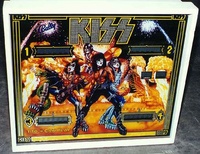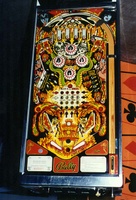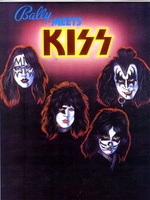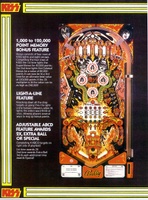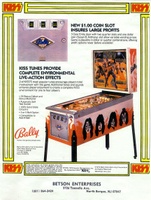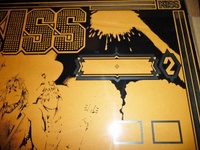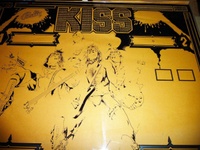

KISS
Used a different power supply than the other 3rd generation tables. The games shipped to Germany had backglasses and playfields with the word KISS having a rounded letter "S" instead of ones shaped like a lightning bolt "S" taken from the runic alphabet. The latter style was used as a double-sig logo and made infamous by Nazi Germany's Schutzstaffel. A 'Kiss' prototype was built which used speech. It was an emergency response to Williams' 1979 'Gorgar', the first talking pinball machine, so Bally pulled a game off of the production line to experiment with, and Kiss happened to be the game in production. Allan Reizman, Engineering Lab Supervisor at Bally from 1977 to 1983, shares his remembrances of this: The talking Kiss prototype did make it out of the lab at least once and was displayed at the 1979 AMOA show in Chicago where it was viewed by all. I believe it said things like, "Shoot the K" and "Kiss!" when you completed a Kiss row. Somebody recently reminded me it groaned, "Too much Rock and Roll!" when you tilted it. The game was only done as a one-time concept. Bally's first talking production pinball machine was Bally's 1980 'Xenon'. Not to be confused with the AMOA talking game, there were also a reported eleven prototype Kiss games made with blue vacuum fluorescent displays. These games did not have speech and used an Intel CPU chip, having three boards: a power supply board, an oversized MPU/IO driver combo board, and a Display board. In our Files section are three schematics that Allan Reizman said are correct for these prototypes only and carry the date and initials of Norm Wurz, Bally draftsman. It was determined the combo board was too large and thus impractical for production use and so Bally went to a separate IO driver board for future development. It was also determined the Motorola CPU chipset was best for pinball applications. Therefore, these Kiss prototype games are a completely different design with no speech than the latter Flash Gordon and Eight Ball Deluxe prototypes. Those games had Squawk & Talk speech and used the Motorola 6803 system as opposed to the Intel and were the test bed for the Bally production 6803 MPU system. In this listing is number three of the reported eleven prototypes made, and the Bally paperwork refers to it as an Engineering Sample. The information provided by its owner is as follows: Bally gave their employee Bruce Kalas this Kiss game on June 29, 1982. Bruce had the game until 1988. Project number NT 1152. Per Bruce, the game did work. The backglass does not lift out, it hinges. There is no on/off switch under the cabinet bottom. The game is supposed to start by typing in a code in the backbox keypad, which has the words Game, Enter, and Test. There are no batteries on the board(s) in the backbox. The ROMS say "experimental". Every coil is marked by hand. The owner subsequently commented on what the original Bally owner had told him about the disposition of the other ten prototypes: This machine (serial number 1152-3) was given to the original owner free by Bally. He said the boss came and told all the workers to come and stand by the machine that they wanted and the Kiss prototypes were the only ones left from which to choose. There were 11 prototypes and he was the last employee to choose so he got prototype number 3. The other 8 were destroyed with sledgehammers. He said he watched them do it. He claims he didn't want the machine but the price was free so he took it. In our Files Section is a Power Supply Schematic unique to these 11 games. We saw handwriting on it stating, "This schematic represents P.C.B. used on 12 Kiss pilots." We asked Allen Reizman of this was his handwriting and if the 12th game was the AMOA talking game. He replied:Yes that's my handwriting. I remember there were 11 Kiss New Tech prototypes deployed. The official name of those games would be, �Intel based, New Technology games�. These games are identified as having a modified standard cabinet with a backbox equipped with blue VF (vacuum fluorescent) alphanumeric displays. The 12th may have been the lab dev game. Only way to confirm the exact number is for everyone with these prototypes report their serial numbers. The Trade show talking Kiss was a one-off marketing project and should not be considered part of the 11 or 12 Intel New Technology games. Talking Kiss used the standard production Motorola board set and displays installed into a one of a kind fiberglass cabinet with a custom sound board added. I doubt there is any surviving documentation for that. A photo or document of the talking Kiss would be an amazing find. Unfortunately, photography at Bally was strictly forbidden at the time. Anyone caught photographing at Bally without permission would have been fired on the spot. Maybe there is a reader out there who attended the 1979 AMOA and who snuck in a camera? In addition to the above prototype games, see also Bally's 1979 'KISS (fiberglass prototype)'.

